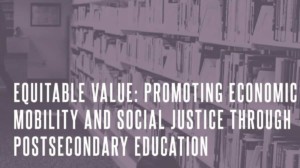Incentives for Equitable Education
The US Education Department (USED) will soon be writing checks totaling more than $100 billion (yes that’s a b) to states and districts. About 95% is just backfilling budget holes–a good thing given the precipitous and potentially disastrous drop in state and local revenues. Unfortunately, USED will be criticized because the money didn’t come soon enough, wasn’t enough, wasn’t fairly distributed, and won’t last forever.
Let’s focus on the roughly $5 billion that could really make a difference. The biggest program, the Race to the Top fund, is a $4.3 billion incentive fund that will be distributed to states on a request basis. USED has a great deal of flexibility in setting criteria for this money. It’s not an easy task implementing a grant program of this size effectively. To put it into perspective, it took a large talented team eight years to invest this amount at the Gates Foundation. Duncan has about eight weeks. And there’s a lot riding on these decisions–the success of Obama’s first term, at least from an education standpoint, will rest on the decisions that are made in the coming weeks.
As USED thinks about a set of forward leaning investment criteria–incentives for equitable outcomes not equitable distribution of funds–the principles of the Education Equality Project (www.EdEquality.org) serve as a great model:
• Ensure that there is an effective teacher in every classroom, and an effective principal in every school, by paying educators as the professionals they are, by giving them the tools and training they need to succeed, and by making tough decisions about those who do not;
• Empower parents by giving them a meaningful voice in where their children are educated including public charter schools;
• Create accountability for educational success at every level–at the system and school level, for teachers and principals, and for central office administrators;
• Commit to making every decision about whom we employ, how money is spent, and where resources are deployed with a single-minded focus: what will best serve our students, regardless of how it affects other interests;
• Call on parents and students to demand more from their schools, but also to demand more from themselves;
• Have the strength in our convictions to stand up to those political forces and interests who seek to preserve a failed system.
Let’s take these principles down one level and get specific about grant criteria. I’d suggest that no state gets a dime without agreeing to:
1. Adopting national standards. It’s time to end the race to the bottom and adopt clearer, fewer, and higher standards. We’re just cheating low income students by giving out diplomas based on watered down standards. And it would be nice to be able to make comparisons of schools and programs across states lines–something that’s very hard to do with different standards everywhere.
2. Tracking and using longitudinal data. We’ve added more measurement to the system but most states, districts, and schools don’t have and don’t use data they way they should. A year end multiple choice dipstick is better than nothing, but schools should be making frequent use of online adaptive assessment and assessing writing, problem solving, and science projects in much more sophisticated (and yes, expensive) ways. Like Florida, we should be able to track young people into college and work so we really begin to understand the educational effectiveness. Better longitudinal data is key to everything else on the list.
3. Eliminating tenure. There’s no place for job guarantees in a performance-based system. You wouldn’t want tenured airline pilots and the work that teachers do is just as important. We’re not very sophisticated about selection and preparation, so the best we can do is leave enough flexibility to retain teachers that add value and non-renew teachers that don’t. Master teachers could be given attractive multi-year contracts recognizing their responsibility and contribution.
4. Differentiated and Performance pay. Higher standards and lower drop out rates will mean twice as many students taking higher level math. We need more great math teachers–fast. That will mean paying more for good teachers and paying more for math teachers. Higher starting salaries and a chance to move quickly to a salary of $70,000 or more will change the applicant pool.
5. Equitable charter funding. First of all, states need a strong charter school law. Second, they need to fund charters equitably and provide facilities.
6. Equitable funding. We still spend, on average, $1000 more on rich kids than poor kids–how does that make sense if you take equity seriously? States need to adopt a weighted student funding model where money follows students.
7. Close and replace failing schools. We’re eight years into NCLB and have identified thousands of persistently failing schools, but Joel Klein and Arne Duncan have closed and replaced more schools in New York and Chicago than any state. It’s time for a little political courage (with the backing of a big grant program). If we take equity seriously, we need to close and replace failing schools. Most states need to follow Louisiana’s lead and set up a Recovery School District with a courageous leader like Paul Pastorek.
8. Effective governance. Let’s admit that our history of local control has left us in a strange place with thousands of very small districts and dozens of very large districts–the former inefficient, the later ineffective. We have enough data to indicate that it is not possible to elect and sustain an effective urban school board. It’s time for a UK-style reform limiting local board authority to decisions about the kids of schools local kids need, and pushing more authority to the school level, and relying on state funding, data, and human capital systems and policies. USED needs to require states seeking grant funding to present plans for serious governance reform.
These are obviously controversial grant criteria. They are the opposite of the ‘spread it like peanut butter’ approach, but that’s what the other $95 billion is for. The risk is that only six or eight states meet these criteria. But that’s not all bad–concentrated funds in places serious about reform is better than funding thin poorly constructed grants.
In addition to a lack of political courage for reform, there’s another problem–a lack of capacity. States simply don’t have the capacity to put together a coherent forward leaning grant proposal. Foundation funding can help provide political coverage and capacity to develop and implement large complicated grant programs. Again, the UK provides a good model. Michael Barber ran a program management office for Tony Blair. They developed policy proposals, monitored implementation, and provided targeted intervention support where intermediate milestones were not met. Thanks largely to the Gates Foundation, there are a number of consulting firms with a robust consulting practice that could provide these planning, monitoring, and intervention services to states.
With help, there may be a dozen states that could meet these eight criteria (or at least agree to begin phasing them in). Other states would adopt part of the program and make progress. The combination would be enough of a critical mass that, in four years, the results of fundamental results-oriented redesign would signal a big win for the Obama administration.
A laundry list of grant criteria with matching philanthropic grants is an attempt to create a framework for a transition to a system that takes results–equitable results–seriously. As Chancellor Klein said recently, “the difference between a process driven and a results driven school system is the difference between day and night.” Our system of locally defined input-driven schools has yielded decades of inequitable results. The USED incentive fund has the potential to live up to its name and be a Race to the Top where, as Klein said the same interview, “there’s no inconsistency between excellence and equity.”
(first appeared on HuffPost, http://www.huffingtonpost.com/tom-vander-ark/incentives-for-equitable_b_183562.html)






Allen Taylor
Nice writing. You are on my RSS reader now so I can read more from you down the road.
Allen Taylor